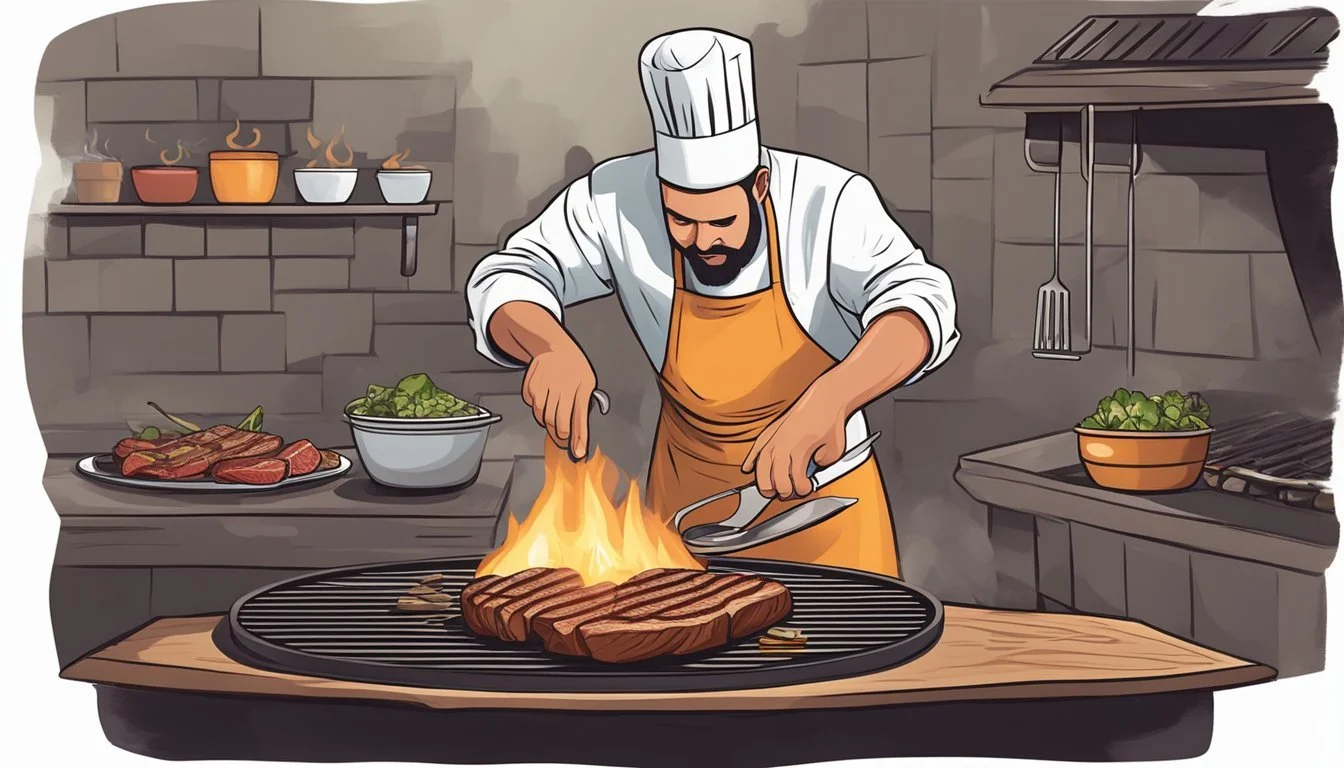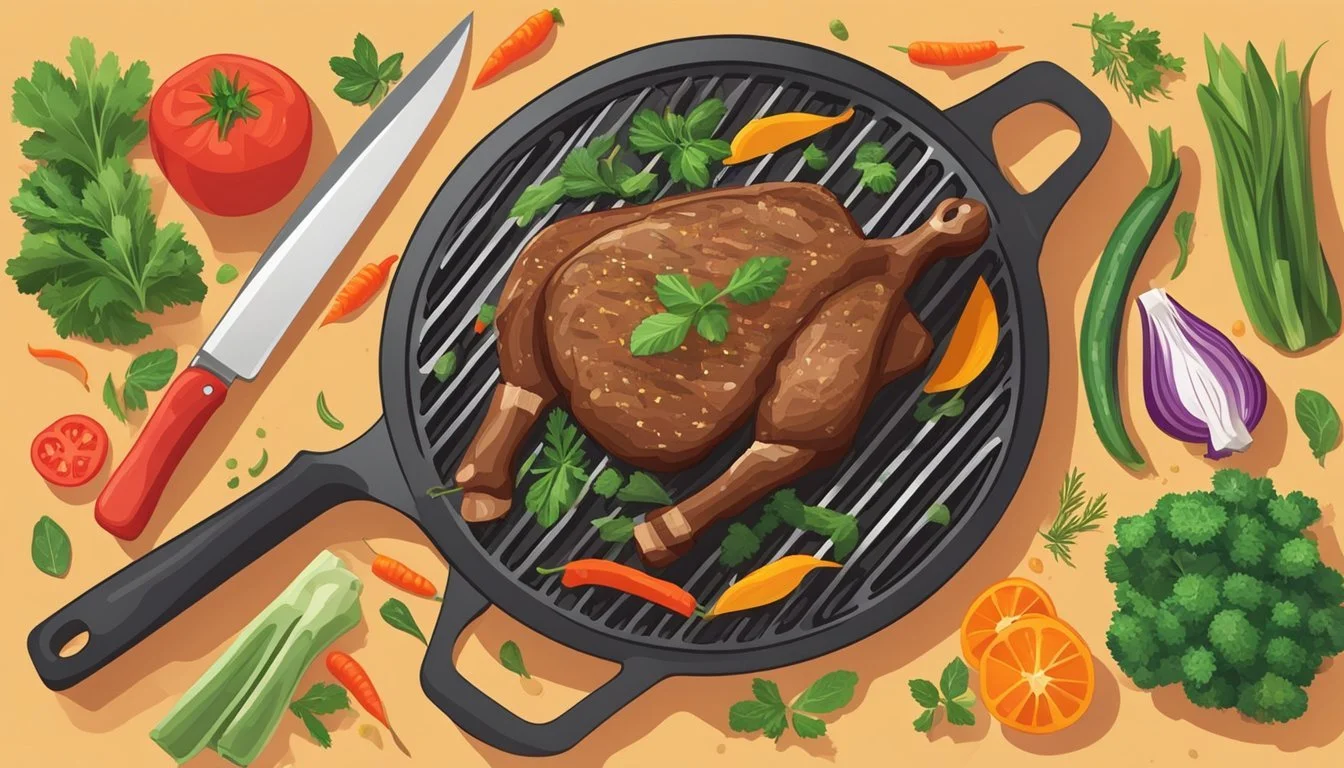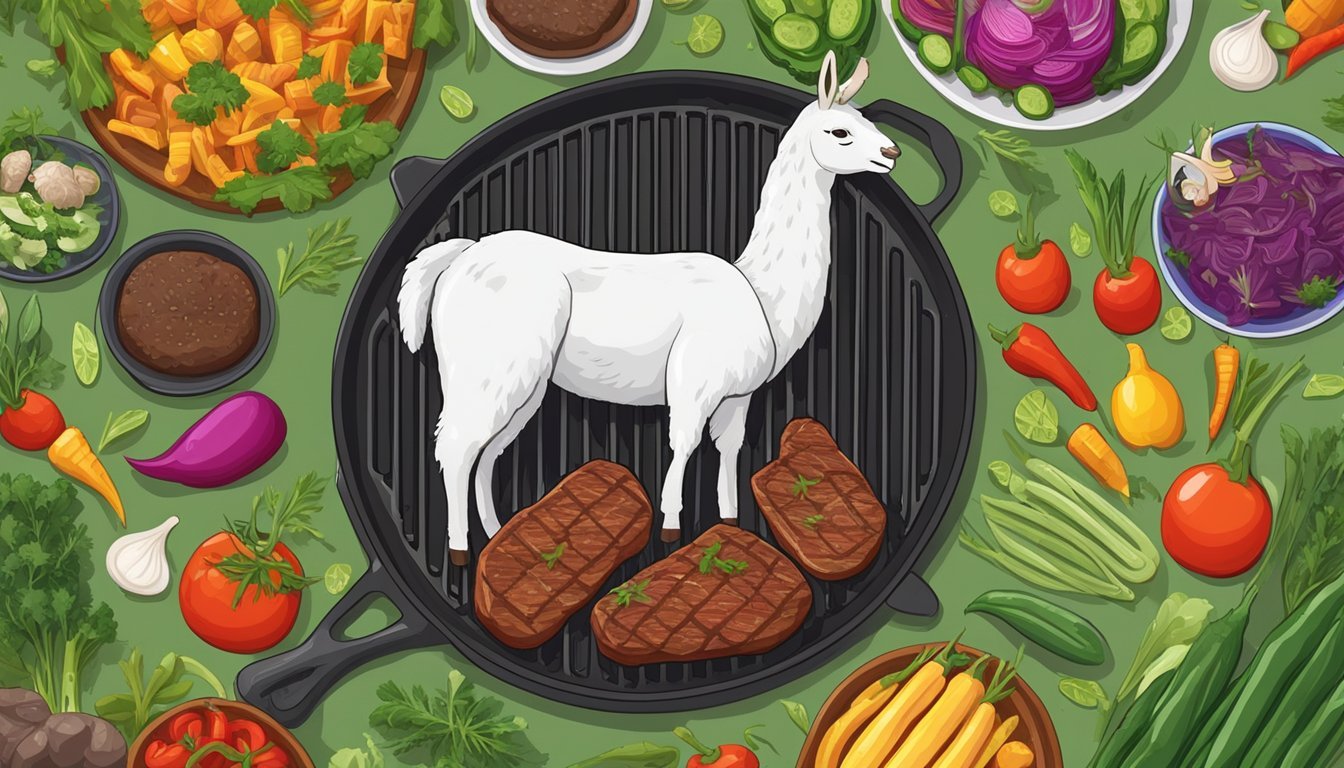Llama Steak
Discover the Andean Culinary Secret for a Tender, Flavorful Meal
Llama steak is emerging as a noteworthy culinary trend beyond its traditional roots in the Andean highlands. Regarded as a delicious and sustainable alternative to beef, llama meat is prized for its tender and flavorful profile. Cultivated for centuries by the indigenous populations of South America, llama is now catching the attention of food enthusiasts and environmentally conscious consumers alike. Its lean nature, coupled with a rich nutrient profile, makes it an excellent choice for those seeking variety in their diets without compromising on taste.
In the high-altitude expanses of the Andes, llamas are an integral part of the landscape and culture. The meat, particularly the tenderloin known as "lomo de llama," is celebrated for its succulence and unique taste. Preparing llama steak can be akin to cooking beef, with methods such as grilling or searing being common techniques to enhance its inherent flavors. Often served as steaks, fillets, or medallions, llama offers an experience familiar to beef while introducing a distinct mouthfeel and richness.
As the global culinary scene continues to expand its palate, embracing llama steak draws attention not only to its gastronomic value but also to its credentials as a sustainable protein source. Its lower fat content and higher protein levels compared to traditional beef make it a compelling choice for the health-conscious, while the smaller environmental hoofprint of llama farming aligns with the growing demand for more eco-friendly food production practices.
Exploring Llama Meat as a Food Source
In the Andean regions, llama meat emerges as a food source rich in protein and intertwined with indigenous culture.
Nutritional Benefits
Llama meat is recognized for its high protein content and low levels of fat and cholesterol. It stands out as a nutritious alternative to traditional beef due to its unique composition.
Protein: A 3.5-ounce serving offers a substantial protein boost, essential for muscle development and repair.
Fat: Comparatively lower in fat, making it a leaner choice.
Iron, Vitamin B12, and Zinc: Rich in these nutrients, which are vital for blood health, energy levels, and immune function.
Culinary Heritage and Tradition
Llama meat has been a staple in the diet of indigenous Andean people for centuries. It's a central part of Andean tradition and culinary heritage, enjoyed in various forms from jerky to tenderloin.
Charki: Dried and salted llama meat jerky, known for its long shelf life and as a hearty snack.
Adobo: A cooking technique involving marinated llama meat, enhancing flavor and tenderness.
Lomo de Llama: A prized tenderloin cut, often compared to beef tenderloin (What wine goes well with beef tenderloin?) for its succulence and versatility in dishes.
Llama meat not only represents the Andean food culture but also signifies the integration of sustainable food practices with a respect for tradition.
Prime Cuts of Llama Steak
In recent years, llama steak has emerged as an excellent alternative to traditional beef steaks, offering tenderness and rich flavors. Before delving into the nuances of llama steak cuts, it is essential to understand how they compare to familiar beef cuts and what to look for in a butcher shop.
Comparing Steak Cuts
When considering llamas, lomo de llama is analogous to the prized beef tenderloin, revered for its tenderness and succulent quality. Here's how some prime cuts of llama steak measure up against classic beef steak cuts:
Llama Sirloin vs. Beef Sirloin: The llama sirloin resembles the boneless top sirloin steak (What wine goes well with sirloin steak?) with its lean texture and heightened flavor profile.
Llama Flank Steak vs. Beef Flank Steak: Lean and flavorsome, the flank steak from a llama provides a similar culinary experience compared to its beef counterpart, suitable for grilling.
Llama Ribeye: While not as fatty as a beef ribeye, the llama ribeye is known for being exceptionally tender, echoing the qualities of the best steak cuts like the ribeye or strip steak in beef.
Butcher Shop Selection
When at a butcher shop, discerning shoppers can identify high-quality llama steaks by their appearance and butcher's presentation. Here are some pointers:
Display: Premium cuts like the tenderloin should be displayed prominently, highlighting their lean, moist, yet tender nature.
Butcher Expertise: A knowledgeable butcher can guide customers through the various cuts available, such as llama sirloin steaks, flank steaks, or ribeye, and offer preparation advice.
To discern the best steak, whether it's a hanger steak or a porterhouse, the principles are the same: look for good marbling, freshness, and proper butchering techniques. Llama steaks, much like their beef counterparts, can be seared, grilled, or roasted to create a satisfying and nutritious alternative to traditional beef options.
Preparing and Cooking Llama Steak
When preparing and cooking llama steak, the focus is on accentuating the meat's natural tenderness and distinct flavor. Through the use of marinades, precise grilling techniques, and alternative cooking methods, one can bring out the best in this lean Andean meat.
Marinating Techniques
Proper marinating is essential for enhancing the llama's flavor profile. A combination of acids and herbs is recommended:
Acids: Lemon juice or vinegar to tenderize
Herbs: Rosemary to infuse aroma
A basic marinade can be created by mixing these with olive oil and allowing the steak to absorb the flavors for several hours, or overnight for a deeper infusion. The use of spices and rubs can be adjusted to taste; however, simpler is often better to let the natural flavor of the meat shine.
Grilling Perfection
Grilling is an ideal way to cook llama steak, aiming for medium-rare to medium:
Preheat the grill to a high temperature before adding the steak.
Cook time: Approximately 4-6 minutes per side, depending on thickness.
Allow the meat to rest for a few minutes after removing it from the grill to ensure the juices redistribute through the steak, maintaining its moisture and flavor.
Other Cooking Methods
Beyond grilling, there are alternative methods for cooking llama steak:
Roasting: A slow-roast in the oven can provide a succulent result.
Braising: For a fall-apart tenderness, braising in a liquid such as a rich stock can be excellent.
Barbecue (BBQ): Slow cooking over indirect heat lends a smoky flavor to the meat.
Each method has its unique way of bringing out the taste and tenderness of llama meat, making it a versatile ingredient for a variety of dishes.
Achieving the Perfect Tenderness
When preparing llama steak, a lesser-known alternative to beef, attaining the ideal tenderness is crucial for enhancing both its flavor and texture. This section will explore effective tenderizing techniques and the significance of meat structure in this process.
Meat Tenderizing Methods
A variety of strategies can be employed to tenderize llama steak. One common approach is to use meat tenderizing powders, which typically contain enzymes like papain or bromelain. These powders can be sprinkled onto the meat, breaking down proteins and muscle fibers. Additionally, mechanical pounding with a meat mallet is effective in physically breaking apart the muscle fibers, thus increasing tenderness.
Cooking methods also play a pivotal role. Slow cooking techniques allow the collagen in the meat to convert into gelatin, resulting in a more tender texture. Marinating with acidic ingredients or seasonings can also help to break down the muscle fibers and enhance the meat's inherent flavors.
Understanding Meat Structure
The structure of the meat is integral to its final tenderness. Llama meat's muscles and fat content are different from beef and require consideration. The marbling, or intramuscular fat, within the llama steak contributes to its tenderness and flavor as it melts during cooking. However, llama meat is generally leaner, meaning careful tenderization is essential to ensure a succulent result.
The presence of collagen within the connective tissue also impacts tenderness. Collagen can be resistant to chewing but slowly transforms into soft gelatin through prolonged moist heat cooking methods. Proper tenderization not only improves the mouthfeel but also allows for the distinctive flavor of llama steak to shine through.
Pairing and Serving Suggestions
When serving and pairing llama steak, utilizing the proper sides and accompaniments can enhance the overall dining experience. Focusing on complementary flavors is essential to highlight the tender and rich quality of the steak.
Sides and Accompaniments
Vegetables: Roasted vegetables make an excellent side for llama steak. Choices such as corn on the cob or a medley including spinach and onions complement the steak well.
Starchy Sides: A classic Italian-inspired option would be a rich parmigiano-sprinkled risotto, or one could opt for potatoes roasted with rosemary and garlic.
Snacks and Street Food: If considering a more casual take, one might pair the steak with small bites of street food such as grilled corn slathered in cheese and spices.
Complementary Flavors
Spices: A rub of spices that include a mix of pepper, rosemary, and a hint of lemon zest can really accentuate the natural flavors of llama steak.
Sauces: Chimichurri, with its vibrant blend of garlic, vinegar, and herbs, can provide a zesty contrast to the steak's richness.
Cheese: A finishing touch of grated parmigiano over the steak can melt and offer a savory depth.
Ham and Eggs: For a twist on surf and turf, thin slices of Italian ham and a runny egg over the steak might be considered, playing on the rich flavors and varied textures.
Cultural Significance of Llama Steak
Llama steak holds a deep cultural significance in the Andean region, rooted in traditions of indigenous communities and adapted by contemporary chefs to influence modern cuisine.
Indigenous Cuisine
The indigenous people of the Andes have incorporated llama meat into their diet for centuries. This tradition stems from the domestication of llamas in regions like Bolivia, where they served as a source of wool, transport, and nourishment. Indigenous cuisine often features llama meat in various forms, such as in empanadas or stews like locro, which resemble the Argentinian and Patagonian lamb dishes in preparation and community gatherings.
Llama steak in these communities is not only a source of sustenance but a means of maintaining a connection to their ancestors. During festivals and special occasions, dishes made from llama meat are prominent, symbolizing a connection to the land and cultural heritage. It’s common to pair these meals with traditional beverages like yerba mate, enhancing the communal experience.
Modern Gastronomic Influence
In contemporary settings, llama steak has emerged as a culinary trend, particularly across cities like Buenos Aires. Chefs have acknowledged the meat's tenderness and mild flavor, utilizing it similarly to beef but with a nod to its unique cultural roots. Llama meat has been transformed into sophisticated dishes that honor indigenous methods while appealing to modern palates.
A recent adaptation would be the incorporation of llama meat into dishes such as milanesa and humitas, presenting a fusion that reflects both the historical significance and the evolving gastronomic landscape. Llama steak is a way for chefs to showcase an alternative protein that resonates with the respect for tradition and sustainability, thus taking a revered component of indigenous cuisine and elevating it within the sphere of high-end gastronomy.
Tips for Selecting and Buying
When seeking out llama steak, consumers should focus on reputable sources and ensure they assess the quality and value of the meat. Finding a balance between price and the lean, yet tender qualities of llama steak will yield the best experience.
Where to Buy Llama Steak
Farmer's Markets: These often offer high-quality options, with the ability to speak directly to the producers about their methods.
Specialty Butcher Shops: They may source llama steak from trusted farms, signifying a commitment to quality.
Online Retailers: A convenient option, though it requires diligence in verifying the credibility of sellers.
Price and Quality Considerations
Expensiveness: Llama meat can be more expensive than traditional beef cuts, reflective of its rarity and lean quality.
Quality Indicators:
Color: A bright red hue indicates freshness.
Marbling: Though leaner than beef, some intramuscular fat is desirable for flavor.
Origin: Locally sourced meat may offer higher freshness and quality.
Butcher Shop Standards: A reputable shop will provide information about the meat's provenance and handling.
Health and Dietary Considerations
When evaluating llama meat as an alternative to traditional beef, one should consider its nutritional profile. Llama meat is considered lean meat, with a lower fat content compared to many red meats. This makes it a potentially healthier option for the heart, as the consumption of high-fat meats is often associated with heart disease.
Nutritional Content of Llama Meat:
Protein: High-quality and complete with essential amino acids.
Fat: Typically lower in saturated fats, beneficial for cholesterol levels.
Calories: Fewer calories than some traditional red meats due to lower fat content.
Benefits for Dietary Health:
Heart Health: Reduced saturated fat intake can help maintain a healthier cardiovascular system.
Weight Management: Leaner meat options contribute to better weight control strategies.
Liver Health: The liver processes fats from the diet, and a lower fat intake can support liver function.
The comparative fat content of llama steak versus traditional beef cuts is notable:
Meat Type
Llama Steak: Lower
Beef Steak: Higher
Dietary Considerations:
Individuals with dietary restrictions or those following a heart-conscious diet may find llama meat to be a suitable alternative. Not only is it leaner, but it also retains the flavorful quality that many seek in red meats, making it a compelling choice for a variety of dishes.
By incorporating llama meat into one's diet, there's an opportunity to enjoy flavorful meals while aligning with healthier lifestyle choices.










